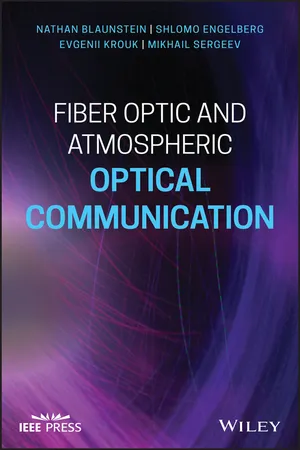
Fiber Optic and Atmospheric Optical Communication
- English
- ePUB (mobile friendly)
- Available on iOS & Android
Fiber Optic and Atmospheric Optical Communication
About this book
A GUIDE TO THE FUNDAMENTAL THEORY AND PRACTICE OF OPTICAL COMMUNICATION
Fiber Optic and Atmospheric Optical Communication offers a much needed guide to characterizing and overcoming the drawbacks associated with optical communication links that suffer from various types of fading when optical signals with information traverse these wireless (atmospheric) or wired (fiber optic) channels.
The authors—noted experts on the topic—present material that aids in predicting the capacity, data rate, spectral efficiency, and bit-error-rate associated with a channel that experiences fading. They review modulation techniques and methods of coding and decoding that are useful when implementing communications systems. The book also discusses how to model the channels, including treating distortion due to the various fading phenomena. Light waves and their similarity to radio waves are explored, and the way light propagates through the atmosphere, through materials, and through the boundary between two materials is explained. This important book:
- Characterizes principal optical sources and detectors, including descriptions of their advantages and disadvantages, to show how to design systems from start to finish
- Provides a new method of predicting and dealing with the dispersive properties of fiber optic cables and other optical guiding structures in order to increase data stream capacity
- Highlights effects of material and multimode (multi-ray) dispersion during propagation of optical signals with data through fiber optic channels
- Presents modulation techniques and methods of coding and decoding that are useful when implementing communications systems
Written for professionals dealing with optical and electro-optical communications, Fiber Optic and Atmospheric Optical Communication explores the theory and practice of optical communication both when the optical signal is propagating through the atmosphere and when it is propagating through an optical fiber.
Frequently asked questions
- Essential is ideal for learners and professionals who enjoy exploring a wide range of subjects. Access the Essential Library with 800,000+ trusted titles and best-sellers across business, personal growth, and the humanities. Includes unlimited reading time and Standard Read Aloud voice.
- Complete: Perfect for advanced learners and researchers needing full, unrestricted access. Unlock 1.4M+ books across hundreds of subjects, including academic and specialized titles. The Complete Plan also includes advanced features like Premium Read Aloud and Research Assistant.
Please note we cannot support devices running on iOS 13 and Android 7 or earlier. Learn more about using the app.
Information
Part I
Optical Communication Link Fundamentals
1
Basic Elements of Optical Communication
1.1 Spectrum of Optical Waves
1.2 Optical Communication in Historical Perspective
- started in 1980;
- wavelength is 800 nm;
- bit rate – 45 Mbps (megabit per second);
- optical te...
Table of contents
- Cover
- Table of Contents
- Preface
- Acknowledgments
- Abbreviations
- Nomenclature
- Part I: Optical Communication Link Fundamentals
- Part II: Fundamentals of Optical Communication
- Part III: Wired Optical Communication Links
- Part IV: Wireless Optical Channels
- Part V: Data Stream Parameters in Atmospheric and Fiber Optic Communication Links with Fading
- Index
- End User License Agreement